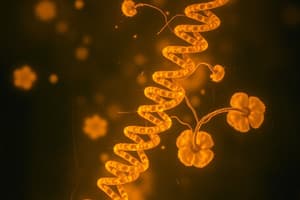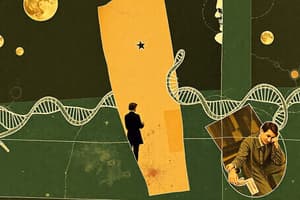Podcast
Questions and Answers
What is the role of the lac repressor in the absence of lactose?
What is the role of the lac repressor in the absence of lactose?
- It catalyzes the breakdown of lactose.
- It binds to the O site, blocking RNA polymerase access. (correct)
- It promotes transcription of structural genes.
- It facilitates the transport of glucose into the cell.
Which enzyme is responsible for cleaving lactose into glucose and galactose?
Which enzyme is responsible for cleaving lactose into glucose and galactose?
- Permease
- Beta-galactosidase (correct)
- Galactosyl transferase
- Lactase
How does allolactose affect the activity of the lac repressor?
How does allolactose affect the activity of the lac repressor?
- It directly initiates transcription of structural genes.
- It inhibits lac repressor activity by enhancing its binding to the O site.
- It increases the expression of glucose transport proteins.
- It induces a conformational change in the lac repressor, preventing it from binding the O site. (correct)
What is the function of CAP-binding protein in the lac operon?
What is the function of CAP-binding protein in the lac operon?
What occurs when lactose is present and glucose is absent?
What occurs when lactose is present and glucose is absent?
What is the result of the phosphorylation of BP-1?
What is the result of the phosphorylation of BP-1?
Which of the following describes a loss of function mutation?
Which of the following describes a loss of function mutation?
What characterizes a gain of function mutation?
What characterizes a gain of function mutation?
What type of mutation results in an amino acid codon being replaced by a stop codon?
What type of mutation results in an amino acid codon being replaced by a stop codon?
Which of the following describes a point mutation?
Which of the following describes a point mutation?
What type of mutation has no effect on the protein produced?
What type of mutation has no effect on the protein produced?
Sickle cell anemia is primarily caused by which type of genetic change?
Sickle cell anemia is primarily caused by which type of genetic change?
Which of the following statements about substitution mutations is true?
Which of the following statements about substitution mutations is true?
What initiates transcription at the 5' UTR of mRNA?
What initiates transcription at the 5' UTR of mRNA?
What happens when histidine is abundant in the surrounding environment during translation?
What happens when histidine is abundant in the surrounding environment during translation?
What genotypic characteristic is associated with Huntington Disease?
What genotypic characteristic is associated with Huntington Disease?
Which of the following best describes chromatin remodeling?
Which of the following best describes chromatin remodeling?
What role do histone acetyltransferases (HATs) play in gene expression regulation?
What role do histone acetyltransferases (HATs) play in gene expression regulation?
Which mutation type occurs naturally without external factors?
Which mutation type occurs naturally without external factors?
What is the consequence when ribosomes stall at histidine codons in the absence of histidine?
What is the consequence when ribosomes stall at histidine codons in the absence of histidine?
What is the impact of having a CTG repeat number between 5-37 in Myotonic Dystrophy?
What is the impact of having a CTG repeat number between 5-37 in Myotonic Dystrophy?
Which modification reduces the electrostatic interaction between histones and DNA?
Which modification reduces the electrostatic interaction between histones and DNA?
What is the likely consequence of having more than 230 CGG repeats in the FMR-1 gene?
What is the likely consequence of having more than 230 CGG repeats in the FMR-1 gene?
The infertility of the FMR-1 gene is due to which phenomenon related to its repeating structure?
The infertility of the FMR-1 gene is due to which phenomenon related to its repeating structure?
Which process is involved in gene expression regulation in eukaryotes?
Which process is involved in gene expression regulation in eukaryotes?
What prevents the formation of the transcriptional apparatus in eukaryotes?
What prevents the formation of the transcriptional apparatus in eukaryotes?
Which of the following statements is true regarding induced mutations?
Which of the following statements is true regarding induced mutations?
What is the critical effect of having more than 150 CTG repeats in Myotonic Dystrophy?
What is the critical effect of having more than 150 CTG repeats in Myotonic Dystrophy?
What type of molecules can contribute to spontaneous mutations through base modification?
What type of molecules can contribute to spontaneous mutations through base modification?
What is the primary cause of Rett syndrome?
What is the primary cause of Rett syndrome?
Which type of mutation leads to a frameshift in the reading frame?
Which type of mutation leads to a frameshift in the reading frame?
What is the expected outcome of a frameshift mutation?
What is the expected outcome of a frameshift mutation?
What characterizes an in-frame mutation?
What characterizes an in-frame mutation?
What mutation leads to Hemoglobin Wayne?
What mutation leads to Hemoglobin Wayne?
How does a frameshift mutation affect the translation of mRNA?
How does a frameshift mutation affect the translation of mRNA?
What is a defining characteristic of genetic homogeneity in sickle cell anemia?
What is a defining characteristic of genetic homogeneity in sickle cell anemia?
What happens to the UAA stop codon in Hemoglobin Wayne's case?
What happens to the UAA stop codon in Hemoglobin Wayne's case?
Flashcards are hidden until you start studying
Study Notes
Negative Regulation by Lac Repressor
- In the absence of lactose, the lac repressor binds to the operator (O site), blocking RNA polymerase access to structural genes.
- This binding results in no transcription or translation.
Positive Control by Induction in the Presence of Lactose
- Permease facilitates the transport of lactose across the cell membrane.
- β-galactosidase hydrolyzes lactose into glucose and galactose.
- Allolactose, formed from glucose and galactose, functions as an inducer by binding to the repressor protein.
- When allolactose binds, the repressor undergoes a conformational change, preventing it from binding to the O site, allowing transcription of structural genes.
- CAP-binding protein enhances transcription in the absence of glucose.
Transcription Regulation Mechanism
- Transcription begins at the 5' untranslated region (5' UTR) of mRNA.
- Ribosome attaches to the Shine-Dalgarno sequence within the 5' UTR, initiating translation of the leader peptide.
- High histidine levels allow for normal ribosome function, while low levels lead to ribosome stalling.
- When stalled, RNA polymerase continues transcription of structural genes.
Mechanism of Gene Expression Regulation in Eukaryotes
- Eukaryotic DNA is associated with histones, preventing the transcriptional machinery from accessing promoters.
- Key mechanisms include chromatin remodeling, histone modification, DNA methylation, gene amplification, and gene deletions.
Chromatin Remodeling
- Involves the displacement of nucleosomes from DNA sequences to activate genes, powered by ATP.
Covalent Modification of Histone Tails
- Acetylation by histone acetyltransferases (HATs) adds acetyl groups, reducing the interaction between histones and DNA, thus promoting transcription.
Mutation Types
- Mutations are heritable changes in DNA sequence and can be small (affecting one or two nucleotides) or large (affecting whole chromosomes).
- Loss of function mutations eliminate gene product function (null mutations); gain of function mutations confer new functions (dominant alleles).
Classification Based on Molecular Change
- Point Mutations: Changes in a single nucleotide.
- Silent Mutations: No change in protein.
- Missense Mutations: Change one amino acid in the protein.
- Nonsense Mutations: Create a stop codon, leading to truncated proteins.
Examples of Diseases Caused by Point Mutations
- Sickle Cell Anemia: Affects red blood cell shape, causing severe pain and infections, a single gene disorder.
- Rett Syndrome: Mainly impacts girls; associated with mutations in the MECP2 gene causing learning and coordination difficulties.
Insertions and Deletions (Indels)
- Indels occur when base pairs are added or removed, affecting downstream translation.
- Frameshift mutations result from indels that aren't multiples of three, leading to altered protein function.
Specific Mutation Effects on Proteins
- Hemoglobin Wayne: Results from a frameshift mutation near a standard termination codon.
- Huntington Disease: Caused by CAG repeat expansions in the HD gene on chromosome 4, with onset dependent on repeat number.
- Fragile X Syndrome: Involves CGG repeats in the FMR-1 gene, excess repeats lead to intellectual disabilities.
- Myotonic Dystrophy: Caused by CTG repeat in the MDPK gene; repeat numbers correlate with disease severity.
Types of Mutations
- Spontaneous Mutations: Occur naturally due to replication errors or internal factors.
- Induced Mutations: Result from external factors like radiation or chemicals.
Sources of Spontaneous Mutations
- Often arise from replication errors that go undetected, with tautomerism of bases contributing to inaccuracies.
Studying That Suits You
Use AI to generate personalized quizzes and flashcards to suit your learning preferences.




